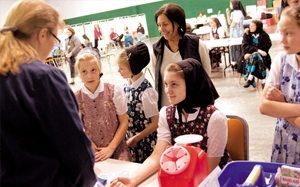Founding genes
By Laura Putre
Photography by Jason Smith
Nearly every winter, Chicago geneticist Carole Ober heads to South Dakota to meet with a group of agreeable farmers. They are the Hutterites; they dress “plain,” like fellow Anabaptists the Amish, and shun modern conveniences in their homes. Holding to Gospel passages that extol the benefits of sharing, South Dakota’s Hutterites communally live on and work their land and purchase goods in common. They don’t smoke, they bear lots of children (on average eight per family), and they marry within their colonies or leave for the secular world.

Hutterite girls line up to have their blood drawn, while Carole Ober looks on.
The South Dakota Hutterites’ uniform environment and common heritage—traceable to a set of 62 founders from the early 1700s through early 1800s—make them a genetic researcher’s dream come true. “If you were to study diabetes on the outside and have 1,000 cases of diabetes, you could have 500 different causes of diabetes in those 1,000,” explains Ober, who notes that the average relatedness between Hutterites is first cousins once removed. “In the Hutterites, we think most people with diabetes have the same genetic reason.”
In search of genetic links to common diseases, Ober and her team have been poking and prodding the community with medical devices since the early 1980s. Her long-term analysis of the group’s medical histories, blood samples, and measurable traits like family size and an antibody called Immunglobulin E has helped bring about some important discoveries related to asthma and fertility in the general population. Most recently, in a study published in the April 17, 2008, New England Journal of Medicine, she and her team found that elevated levels of a blood protein called YKL-40 predicted asthma in Hutterites. Ober then looked for correlations between relatives and found that the protein elevation was primarily due to a genetic variation. “We were able to find a gene that has a very strong influence on YKL-40 levels, and we were able to show that same gene influenced risk for asthma and lung function,” says Ober. They replicated the results in patients in Chicago and in Freiburg, Germany, confirming this gene’s role in asthma.
Ober and graduate student Gulum Kosova are also trying to figure out whether some genes help determine variation in human fertility. Evolutionary literature suggests that genetic variation influencing fertility should have been eliminated from the population by now. But Kosova’s study of sex-specific genes in 465 Hutterite husbands and wives showed that fertility traits were inherited in both men and women. The study found that 12 percent of variation in females’ family size and 90 percent in males’ is traceable to genetic variation. The difference in percentages is not all that surprising, says Ober. As childbearers, women have more nongenetic factors involved in their fertility than men; men have many more fertility genes.
Over the years, Ober and the Hutterites have built a friendly collaboration. “Probably the best thing about the Hutterites is they’re just a wonderful group of people who love to be in our studies,” she says, adding that the free medical workup—heart work, carotid-artery scans, and “fancy eye work and lung stuff”—is a big selling point. “If they hear we’re coming to South Dakota to a particular colony, we get calls from all these other colonies: can they come and be tested while we’re there?”
Ober inherited the Hutterites, so to speak. In the 1950s Arthur Steinberg, a geneticist at Case Western Reserve University, thought the isolated community would be ideal for studying the genetics of common diseases. He took his students to visit the colonies, then sent them to Russia and Germany to assemble a genealogy. “We just add to it as more people are born,” says Ober. When Steinberg retired he passed the information to a former student, Northwestern geneticist Alice Martin, Ober’s postdoctorate adviser. When Martin left academia to become a patent lawyer, the Hutterites’ legacy landed in Ober’s lap. Today they number about 50,000; they live in more than 450 colonies scattered throughout the northwest prairie states and Manitoba and Alberta, Canada.
In 1996 Ober began inviting other Chicago-area specialists along on her annual trips to South Dakota. “We now go out there with a team of 30 people from Chicago,” including cardiologists; an ear, nose, and throat doctor who studies sinusitis and smell; a pediatric pulmonologist; and a genetic ophthalmologist from Children’s Memorial Hospital. Perhaps Ober’s most valuable traveling companion is Ruth Wipf, a 16-year-old Hutterite who makes sure patients know when they’re scheduled and organizes their paperwork. “We met her on one of our trips,” says Ober, “and she was so incredibly fantastic in helping us organize our study of the colony that I got permission from her minister to take her with us on every trip we make. Every morning when we’re there, the first thing I do is pick up Ruth.”
In future fertility studies, Ober hopes to find “the genes responsible for the differences between individuals and then determine if mutations in those genes contribute to infertility in the general population, and perhaps identify novel therapeutic treatments.”
Return to topWRITE THE EDITOR
E-MAIL THIS ARTICLE
SHARE THIS ARTICLE
RELATED READING
- Medicine on the Midway: Genetic Isolation pdf (Spring 2008)
- Chicago News Office: Gene Variant Increases Risk of Asthma (Apr. 10, 2008)
- AFP: Gene Variation Directly Affects Lung Health: Study (Apr. 10, 2008)
